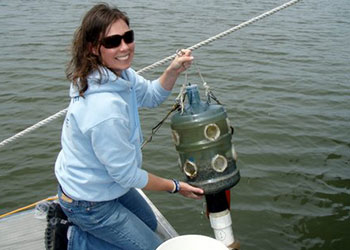Research in the Marine Invertebrate Fisheries and Conservation Lab (resident scientist Laura Rogers-Bennett, Center for Wildlife Health and California Department of Fish and Wildlife) focuses on examining processes which impact marine invertebrate populations and communities then applying these findings to fisheries management and marine conservation issues. Marine invertebrates have become the most important fisheries in California in terms of both volume and value. In 2012, four of the top five fisheries were marine invertebrates. Unfortunately, an understanding of the life histories, biology and population dynamics of many of California marine invertebrate fisheries lags behind. The Rogers-Bennett lab’s research focuses on gathering data to inform the life history information and fisheries management of marine invertebrates. Their work is centered in nearshore kelp beds in northern California home to two important marine invertebrates that support fisheries.
Red abalone, Haliotis rufescens, are the foundation for an important recreational fishery north of San Francisco. More than 38,000 divers and rock pickers take, on average, 260,000 abalone per year. Researchers on the Rogers-Bennett lab are quantifying the growth and reproduction rates for red abalone in northern California. They use these data to develop matrix population modeling tools to ask questions about the efficacy of the existing size limits and Marine Protected Areas (MPAs). They also work to determine the relationship between abalone density and aggregation characteristics. Recently, the Rogers-Bennett lab has been working to determine the cause of a large-scale red abalone die off in Sonoma County which occurred in Aug. 2011 coincident with a Harmful Algal Bloom. 
The second fishery that the Rogers-Bennett lab tracks and studies is the commercially exploited red sea urchin, Strongylocentrotus franciscanus, fishery. This is a dive fishery and is frequently one of the top five fisheries in the state. This fishery is based on the gonad of both sexes and gonad quality is a major determinant of this fishery. They have been working to track not only red sea urchin density (Fig. 1) but also gonad quality inside and outside MPAs.
A network of MPAs has been established in California. The Rogers-Bennett Lab is working inside and outside MPAs in the North Central and North coast regions to examine the impact of no fishing on both the red abalone and red sea urchin fisheries. This is accomplished by using dive surveys which were started in 1999. The Dungeness crab (Metacarcinus magister) fishery in 2012 was the second most valuable fishery in California. These crabs are notorious for large population fluctuations from year to year and the mechanisms driving these swings are poorly understood. The last three years have been very good years for the fishery with record-breaking landings. Since 2007, the Rogers-Bennett Lab has been sampling the recruitment of larval crab megalopae at key bays in northern California. By quantifying the scale of recruitment they are working with our partner in Oregon to develop an indicator of the strength of the fishery. There are findings that oceanographic conditions during the year are impacting the scale of recruitment at this early life history stage.

